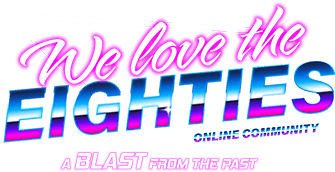Navigation
Install the app
How to install the app on iOS
Follow along with the video below to see how to install our site as a web app on your home screen.

Note: this_feature_currently_requires_accessing_site_using_safari
More options
You are using an out of date browser. It may not display this or other websites correctly.
You should upgrade or use an alternative browser.
You should upgrade or use an alternative browser.
neon lights
Hey!
Welcome to We love the Eighties Community! We’re thrilled you’ve stopped by our ’80s paradise. 🌟 Here, we celebrate all things ’80s – from iconic music, movies, fashion, to the vibrant culture that defined a generation! Feel free to introduce yourself and start exploring the threads. Don’t hesitate to share your thoughts, memories, or even your latest ‘80s finds! We’re excited to have you join our vibrant community. Join us to connect with fellow enthusiasts, share your favorite memories, and dive into engaging discussions that bring the nostalgia of the ‘80s to life. Whether you’re a die-hard fan or just curious about this dynamic era, you’ll find a home here.
Neon lighting consists of brightly glowing, electrified glass tubes or bulbs that contain rarefied neon or other gases. Neon lights are a type of cold cathode gas-discharge light. A neon tube is a sealed glass tube with a metal electrode at each end, filled with one of a number of gases at low pressure. A high potential of several thousand volts applied to the electrodes ionizes the gas in the tube, causing it to emit colored light. The color of the light depends on the gas in the tube. Neon lights were named for neon, a noble gas which gives off a popular orange light, but other gases and chemicals called phosphors are used to produce other colors, such as hydrogen (purple-red), helium (yellow or pink), carbon dioxide (white), and mercury (blue). Neon tubes can be fabricated in curving artistic shapes, to form letters or pictures. They are mainly used to make dramatic, multicolored glowing signage for advertising, called neon signs, which were popular from the 1920s to 1960s and again in the 1980s.
The term can also refer to the miniature neon glow lamp, developed in 1917, about seven years after neon tube lighting. While neon tube lights are typically meters long, the neon lamps can be less than one centimeter in length and glow much more dimly than the tube lights. They are still in use as small indicator lights. Through the 1970s, neon glow lamps were widely used for numerical displays in electronics, for small decorative lamps, and as signal processing devices in circuitry. While these lamps are now antiques, the technology of the neon glow lamp developed into contemporary plasma displays and televisions.Neon was discovered in 1898 by the British scientists William Ramsay and Morris W. Travers. After obtaining pure neon from the atmosphere, they explored its properties using an "electrical gas-discharge" tube that was similar to the tubes used for neon signs today. Georges Claude, a French engineer and inventor, presented neon tube lighting in essentially its modern form at the Paris Motor Show, December 3–18, 1910. Claude, sometimes called "the Edison of France", had a near monopoly on the new technology, which became very popular for signage and displays in the period 1920–1940. Neon lighting was an important cultural phenomenon in the United States in that era; by 1940, the downtowns of nearly every city in the US were bright with neon signage, and Times Square in New York City was known worldwide for its neon extravagances. There were 2,000 shops nationwide designing and fabricating neon signs. The popularity, intricacy, and scale of neon signage for advertising declined in the U.S. following the Second World War (1939–1945), but development continued vigorously in Japan, Iran, and some other countries. In recent decades architects and artists, in addition to sign designers, have again adopted neon tube lighting as a component in their works.Neon lighting is closely related to fluorescent lighting, which developed about 25 years after neon tube lighting. In fluorescent lights, the light emitted by rarefied gases within a tube is used exclusively to excite fluorescent materials that coat the tube, which then shine with their own colors that become the tube's visible, usually white, glow. Fluorescent coatings (phosphors) and glasses are also an option for neon tube lighting, but are usually selected to obtain bright colors.
View More On Wikipedia.org
The term can also refer to the miniature neon glow lamp, developed in 1917, about seven years after neon tube lighting. While neon tube lights are typically meters long, the neon lamps can be less than one centimeter in length and glow much more dimly than the tube lights. They are still in use as small indicator lights. Through the 1970s, neon glow lamps were widely used for numerical displays in electronics, for small decorative lamps, and as signal processing devices in circuitry. While these lamps are now antiques, the technology of the neon glow lamp developed into contemporary plasma displays and televisions.Neon was discovered in 1898 by the British scientists William Ramsay and Morris W. Travers. After obtaining pure neon from the atmosphere, they explored its properties using an "electrical gas-discharge" tube that was similar to the tubes used for neon signs today. Georges Claude, a French engineer and inventor, presented neon tube lighting in essentially its modern form at the Paris Motor Show, December 3–18, 1910. Claude, sometimes called "the Edison of France", had a near monopoly on the new technology, which became very popular for signage and displays in the period 1920–1940. Neon lighting was an important cultural phenomenon in the United States in that era; by 1940, the downtowns of nearly every city in the US were bright with neon signage, and Times Square in New York City was known worldwide for its neon extravagances. There were 2,000 shops nationwide designing and fabricating neon signs. The popularity, intricacy, and scale of neon signage for advertising declined in the U.S. following the Second World War (1939–1945), but development continued vigorously in Japan, Iran, and some other countries. In recent decades architects and artists, in addition to sign designers, have again adopted neon tube lighting as a component in their works.Neon lighting is closely related to fluorescent lighting, which developed about 25 years after neon tube lighting. In fluorescent lights, the light emitted by rarefied gases within a tube is used exclusively to excite fluorescent materials that coat the tube, which then shine with their own colors that become the tube's visible, usually white, glow. Fluorescent coatings (phosphors) and glasses are also an option for neon tube lighting, but are usually selected to obtain bright colors.
View More On Wikipedia.org
-
B
A Tribute to the ‘80s: A Decade that Refuses to Be Forgotten
This thread is for the general discussion of the Article A Tribute to the ‘80s: A Decade that Refuses to Be Forgotten. Please add to the discussion here.- Brad Bartlett
- Thread
- 80s mania 80s playlist 80s tribute cultural tributes entertainment fashion neon lights nostalgia
- Replies: 2
- Forum: The 80s Lounge
-

A Tribute to the ‘80s: A Decade that Refuses to Be Forgotten
Have you ever noticed that some things never seem to... fade away? No matter how much time passes, they stubbornly remain in public consciousness. The 1980s is one decade that refuses to be forgotten. From big hair to neon colors, the 1980s was a vibrant decade that made a permanent mark on...- Brad Bartlett
- Article
- 4 min read
- 80s mania 80s playlist 80s tribute cultural tributes entertainment fashion neon lights nostalgia
- Category: 80s Decade

